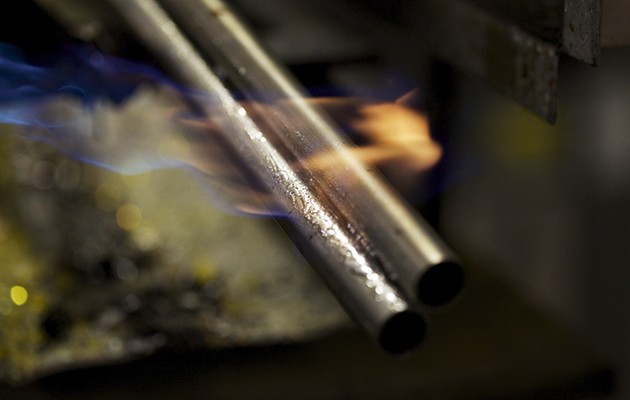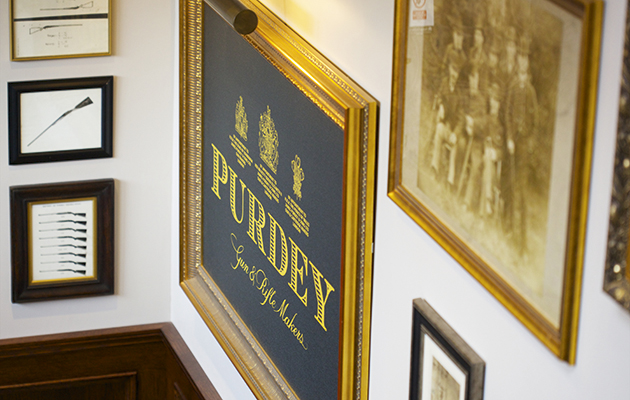The Field was given exclusive access to the newly renovated Purdey factory, brimming with cutting-edge technology. Michael Yardley meets the men and machines
The Purdey factory has been renovated. At its premises in Felgate Mews, Hammersmith, it has been transformed into the ideal environment for everyone on the premises, from visitors to the engineering teams. Michael Yardley goes to see the new Purdey factory, affectionately known as “the workshop”.
For more on Purdey, read our latest review of the Purdey Woodward .410.
THE PURDEY FACTORY
James Purdey & Sons, founded in 1814, is probably the most famous bespoke gunmaking firm in the world, with an international reputation for impeccable craftsmanship. So the opening of a new Purdey factory – known as “the workshop” – as a centre of excellence is significant for all who value traditional gunmaking.
I had visited the old Purdey factory at the same Felgate Mews site in Hammersmith several times. Purdey moved there in 1979, having migrated from workshops around Paddington that the firm had occupied since 1900. The Felgate premises, a converted slaughterhouse, were a bit Dickensian and a decision was made to rebuild to create the new Purdey factory. In 2011 there was a run-off between architects, with Nash Partners (designers of the new Westley Richards showroom and factory in Birmingham) winning.
The idea behind the Purdey factory building (which has a brick-clad steel frame and boasts a substantial courtyard, its own underground range and covered car parking) was to make an ideal environment for the artisans, engineering teams and visitors.
At the centre of the new Purdey factory is a large, naturally lit, first-floor, benched studio for about 25 craftsmen. There is also an ultra-modern machine shop and adjoining CAD design suite where computer-design specialists are busy digitising the dimensions of definitive Purdey models as well as programming and controlling the sophisticated machines nearby for daily production requirements. Forty-five people work in the Purdey factory with another 30 at Audley House, the firm’s Mayfair headquarters. Roughly speaking, that is one person for every gun Purdey makes annually.
Edward Nash of Nash Partners told me, “We showed Purdey how they could utilise this site to discover qualities of the working environment for both gunmakers and customers that previously had not been enjoyed. We thought a lot about the approach to the building with the new yard. In the Victorian era there was often a courtyard for security. We put one in here for that purpose and to improve the experience of coming into the Purdey factory.”
Nash noted special challenges. “Top lighting is vital for the bench workers but you have to consider how this will work during the day and through the seasons,” he explained. “Much testing was carried out using lighting models for the Purdey factory. You have to avoid glare, especially when the sun is low. Acoustics need to be considered as well, most notably in the machine shop and firing range. There are so many stages in gunmaking and different activities create different acoustic conditions. One has to take these into account and consider the needs of the different craftsmen within the Purdey factory. Engravers, for example, have very demanding work and need precisely the right conditions. We spent much time with the individual craftsmen, understanding their needs.”
The Purdey factory range measures 70 metres and has electronic impact detectors. Although Nash Partners had designed one for Westley Richards it was not part of the original brief for Purdey. As the project progressed it became obvious that there was room for one so it was added. This was a challenge both because of the noise issues – local residents could not be disturbed – and because the water table is so high in London that the structure had to be tanked. The weight of the Purdey factory building is cleverly used to keep it all in place.
INSIDE THE PURDEY FACTORY
So what is the new Purdey factory like? As you enter the premises they appear substantial without being excessively modernistic. Walking through the pleasant, gated courtyard and understated entrance, you go up to a first-floor conference room via a stairwell in which hangs a portrait of the founder James Purdey (1784-1863). Accompanied by the Editor, I had discussions there with Laurie Bayliss, the production director, and Jonathan Irby, head of sales, before walking into the bench area that forms the heart of the Purdey factory.
The equally important machine shop is on the ground floor of the Purdey factory. It includes four large CNC milling machines and two wire-cutters (another form of hi-tech apparatus) with an adjoining CAD suite. The machines are similar to those one might encounter elsewhere but the Purdey approach to using them is different. CNC techniques are used to manufacture parts specifically designed for final completion by hand; the bonus, apart from accuracy, is to eliminate waste of craft time filing away surplus metal. I saw a tray of V-springs in the machine shop and asked whether these had been “wire cut”. No, they were traditionally made and tempered. The machines allow time for their craftsmen to do “one-offs”, a challenge they enjoy, and to restore vintage Purdey guns.
Back in the bench studio, we walked among the lines of craftsmen. There are areas devoted to all the traditional trades – actioning, stocking, barrelmaking, engraving, finishing and so on – each typically populated with several focused men engaged in their respective specialities. Some were well known to me and we chatted about the new Purdey factory building as well as gunmaking, all of them agreeing that it was a significant improvement and a pleasant place to work. The highlight of the trip was the visit to the range where there was an opportunity to shoot a big-bore, .400 class double accompanied by ex-Royal Marine, Ian Moran.
THE MAKING OF A PURDEY
Apart from the fact that the action is part-machined by CNC, the way a Purdey is made has not changed much in 200 years. A number of craftsmen are still involved in its manufacture. Besides the modern input, the skills of seven key artisans – barrelmaker, actioner, lockmaker, ejector man, stocker, engraver and finisher – are called upon. And it still takes about a thousand hours to complete a gun, depending on specification.
Most Purdeys begin with a bespoke order although some are made for the shelf. Once the gun is specified and the customer’s measurements recorded – the preference is to take measurements at the West London Shooting Ground using a try gun, although measurements can be taken in the shop or guns can be made to measurements supplied by the customer – the dimensions are sent through to the factory where the manufacturing process begins with the barrels. These are made from chopper-lump tubes usually supplied by Microfinish. However, Purdey is now exploring manufacturing them in-house. Having been “struck-up” with rectangular hand files, they are brazed together. Lumps and “lugger” (extractor) recesses are cut, and ribs fitted traditionally by tin solder.
The action body, always dedicated to bore size, comes through unfinished from the machine shop and passes into the hands of an actioner. He fits the barrels to the action, jointing them and bringing the hook of the front lump on to the bearing surface of the cross-pin and the barrel faces on to the front of the standing breech. This key process requires much use of a smoke lamp. The fore-end iron is then fitted. The lock plates come next and holes are drilled and tapped for the sidelock pins. “Lever work” follows (top lever, spindle, and bolt – the sliding component visible in the base of the action body that locks the gun up).
The next stage is “nippling” when discs and firing pins are fitted. Bites are adjusted. The “fences” (balls of the action body) and beads are filed up by hand, as ever. Once this is done the gun is ready for the completion of ejector work (save final regulation). When the barrelled action is complete “in the white” and passes inspection (and there are many inspections in the gestation of a Purdey), it goes to proof at the London Proof House, run by the Worshipful Company of Gunmakers. Having passed proof, the barrelled action is returned to the Purdey factory and delivered to the stocker.
That process begins with a blank of Turkish walnut (Nigel Beaumont, a director of the firm and formerly the chairman, visits the walnut suppliers to select the timber every year), which may have been stored for many years. Measurements are taken from the factory office and a pattern is put on to the stock blank. The top profile is cut with a bandsaw, then the main body of the action is “headed-up” on to the marked-out walnut blank with the top strap having been set for cast and bend.
The lock plates are let in, then the lockwork mechanisms and triggers are hung and the safety mechanism fitted. Trigger and lock plates go in before their respective mechanisms, the stocker having also set lock plates and top strap for appropriate cast and bend (drop) as required. The stock, once headed, is shaped up using templates/gauges to maintain the integrity of classic Purdey shapes. Once the basic work is done, the grain is lifted, and the butt and fore-end papered-up, chequered, and oiled with Purdey’s secret “Slacum” recipe (the hand-rubbed oil that may take a couple of months to apply and finish). The gun also passes through the extraordinarily skilled hands of the finishing department.
Purdey is increasing its range of guns. Most are built on a bespoke basis (with delivery in 18 to 24 months) but those made for the shelf may be available in eight to nine months. These are known in-house as “JPS” stock and typically have long stocks and neutral cast and bend measurements, allowing for easy alteration. The over-and-under sporter, made in association with Perugini & Visini, can also be had, fully bespoke, within eight to nine months. (The actions and monoblocs of these guns are machined in London.)
THE COST OF A PURDEY
So much does one pay for a Purdey? A classic side-by-side game-gun starts at £82,000, excluding VAT, in 12-, 16- or 20-bore. The 28-bores and .410s start from £82,600. The over-and-under game-gun, based on the Woodward 1911 patent, begins at £90,600 in 12-, 16- and 20-bore, with the 28s and .410s costing from £96,100. Double rifles begin at £115,000 up to calibre .577 Nitro Express, and £122,000, excluding vat, for bigger calibres.
My favourite, the side-by-side hammer ejector, is £82,600 in 12- or 20-bore (the only bore sizes available at the moment). The extraordinary Damas-steel guns begin at £96,400 for the side-by-side and £108,600 for the over-and-under. The Purdey Sporter is the most affordable and starts at £32,000, excluding VAT.
All Purdey classic production may include such extras as custom engraving, gold lettering, single triggers, special ribs, ventilated heel plates, beavertail fore-ends, leather-covered recoil pads and Teague chokes. These can add to the bottom line significantly. The base price (save the Sporter model) does, however, include a leather motor case.














